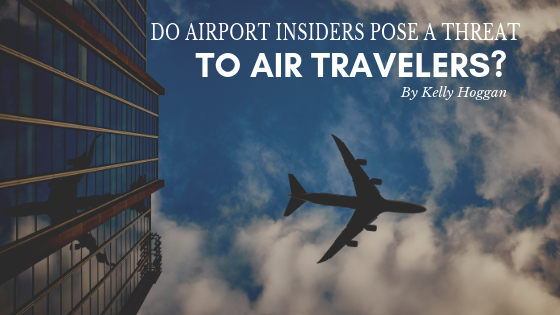As we’ve previously noted, in terms of threat, an airport insider is “a person who exploits, or has an intention to exploit, their role or knowledge for unauthorized purposes.” The term “airport insider” can apply to full or part-time permanent employees or staff of an airport or its tenant airlines or businesses within the airport, for example, as well as temporary or contractor personnel. But just how serious is the threat to commercial aviation airport insiders pose, and what sorts of background vetting or investigations occur before they’re even brought on board?
The first thing to understand when it comes to dealing with threats posed by airport insiders is that they present no standard profile. In other words, anyone with insider access to an airport can pose a severe threat or absolutely none. However, some insiders do present certain common traits. For example, insiders may have excessive feelings of self-importance or self-esteem. They might also be arrogant in dealing with co-workers and colleagues and demonstrate a manipulative nature.
At the opposite end, some airport insiders might display abnormally low self-esteem, be standoffish or extremely reclusive while on the job or otherwise seem “odd.” Unfortunately, almost anyone who’s worked at an airport has at least one story to tell about a colleague who would fly off the handle at the slightest change to his work environment. The problem with such behaviors as we’ve cited is that possession of one or even many such traits by an airport worker doesn’t necessarily mean they present a threat, either now or in the future.

To compound the issue, airport and airline security officials must also worry about threats posed by “unintentional insiders.” These kinds of airport insiders don’t intend to cause harm to fellow workers or colleagues or do damage to airports. But by failing to follow security procedures, say, they could be leaving their airport and co-workers open to severe threats or attacks by others or by non-state terror groups or terrorist cells.
The bottom line is that both malicious, as well as unintentional airport insiders, can cause equally devastating damage through the exploitation of their personal vulnerabilities or by groups and people intent on doing great harm to an airport or airlines and their passengers. And, sadly, there have been cases in the last several years where airport insiders have indeed caused damage through acts of commission or omission. So, then; what’s being done to mitigate or eliminate the potential threat posed by such insiders?
It’s important to understand that there’s no “one size fits all” solution to potential threats posed by insiders working at an airport, nor is there a magic wand available which will eliminate the problem. Depending on their size, U.S. airports typically are “hardened” against a range of projected possible terror threats, which are commonly known as “anti-terror measures.” These measures may also be present to one degree or another in secure airport areas accessible only to employees or others granted controlled access.
Currently, more than 1 million U.S. airport workers possess badges giving them some level of access to secure areas of the airports in which they work. These “SIDA badges” (SIDA is an acronym for “Security Identification Display Area”) are issued to airport workers after completion of a security background check. As we note later in this article, the level of initial background check scrutiny given to prospective airport and airline employees can be a source of concern. Even at that, though, the Transportation Security Administration does monitor all SIDA-badged airport workers daily. The agency does this through use of the government’s Terrorist Screening Database, or TSDB, with the airport worker whose name “pops up” in the database immediately flagged for questioning and other measures.
For sure, airports and airlines could also do even more when it comes to their workers and employees and the security access they’re given. The government could make participation in the FBI’s Rap Back program mandatory, for example. (“Rap” stands for “Record of Arrest and Prosecution,” while “Back” is short for “background.”)
Employers such as airlines that are enrolled in federal or state-level Rap Back programs, for instance, can receive ongoing notifications and updates in real-time about any run-ins with law enforcement their employees may experience. This includes not only any convictions but also arrests, and it helps deal with a flaw present when only intermittent background checks are performed on airport workers: Unfortunately, there’s no consistent way for airports, airlines and other employers to discover if their employees have interacted with law enforcement and the criminal justice system until their next background check is performed.
A serious downside to the above, in the case of airport insiders with SIDA badges, is that another background check might not be performed until an employee’s SIDA access badge is up for renewal. This may be one or two years, at minimum, once it’s been issued or previously renewed. At the least, airports and airlines with workers needing access to higher-level areas such as airliners, baggage sortation and assembly areas and the like should participate in Rap Back for those employees.
One of the most effective ways to lessen the possibility of insider threats at an airport, however, is to ensure ALL prospective employees undergo robust and very thorough pre-employment screening. After that, regular follow-up screening – such as through Rap Back – can and should be employed. Such background checks or another vetting must also be thorough enough to prevent insider infiltration by people hiring on at an airport to do harm to it or the people and planes within. And while at the airport, all workers should undergo security screening as they move above sensitive areas, though many don’t once they’re given a screening upon entrance to the facility.
Yet another issue is that such thorough background checks, which are usually performed by the federal government and its law enforcement agencies, are both time-consuming as well as expensive. No airport or its airline tenants and vendors could afford to wait weeks or months, or even longer, for the completion of the kinds of vetting the federal government performs on many of its own employees. They also couldn’t afford to pay for the cost of security screening many hundreds or thousands of their potential as well as current employees regularly.
(Here, it’s worth noting that opinions differ between U.S. aviation security officials and their European counterparts when it comes to screening of aviation and airport insiders. In Europe, most airport workers regularly undergo the same security screening air travelers are subjected to, at minimum, especially when they need to enter higher-level-security areas such as going onto airliners or working around them. In the U.S., the level of security screening of airport workers possessing security access badges runs the gamut from random, low-level screening – or no additional screening at all once they’ve been checked upon initial entry to airport secure areas — up through full, thorough and regular screening.)

To save money – because the background checks and security clearance investigations described above can cost a great deal – most airport workers undergo much more limited vetting. This group of “exempt” employees includes baggage handlers, aircraft cleaners, mechanics, caterers and fuelers, all of whom have regular, unmonitored, and unescorted access to airliners.
Generally, hopeful airport and airline workers and vendor employees undergo only a check of the FBI’s criminal history database as well as a simple drug test after filling out a questionnaire. These checks are typically left to an airport’s security badging and access office. Checking of a prospective employee’s references and employment history and U.S. work eligibility is the responsibility of the individual employer. Besides cutting down on time needed to process this kind of vetting, it’s also far more affordable for airports and employers, as they’re charged for the cost of such investigations.
Given the above limited-scope background investigations most airport insiders undergo, it’s easy to see how personal vulnerabilities can be exploited. Some airport workers may have serious financial problems which open them up to blackmail or other pressure from bad actors seeking to attack their airports. Other workers might have connections to non-state terror groups or cells. Some airport insiders no doubt have suffered from (or are still suffering) mental health problems that could lead them to act out in potentially deadly ways.
So, what can be done to screen airport employees more thoroughly? Some experts recommend structuring airport worker background checks based on risk. For example, an employee working at an airport concourse fast food restaurant requires less vetting than a baggage handler loading passenger luggage into the belly of an aircraft or a mechanic repairing an airliner’s engines. The fast-food worker at an airport is typically given only limited access to other areas of the facility and usually must go through TSA security screening to get to his work area. Airport baggage handlers and mechanics have far more unsupervised access to sensitive areas, however, so it only makes sense they undergo a more thorough background investigation.

Limited-scope background investigations like the ones performed on military recruits, while not cheap, also aren’t expensive. Known as a “NACLC,” or “National Agency Check with Local Agency and Credit Checks,” this type of vetting is more thorough than the one currently applied to many airport insiders. Possible credit or financial issues, as well as local law enforcement run-ins by airport job applicants, are just two of the areas explored when a NACLC is requested. Airport employees needing access to more sensitive areas or whose background investigations reveal serious issues would be subjected to more intensive study before issuance of an airport badge.
The above is just a start when it comes to ensuring airport insiders pose no threat to their airports or to passengers as well as the airliners on which they fly. There remains the issue of how to adequately screen and monitor airport workers as they go about their daily activities out on the tarmac and in other sensitive areas, which is an issue we’ll explore in the next article.
Kelly Hoggan, Founder and CEO of H4 Solutions, previously served as assistant administrator for operations at the Transportation Security Administration. In that role, he was responsible for aircraft and checkpoint security operations at the nation’s 400-plus commercial airports.



